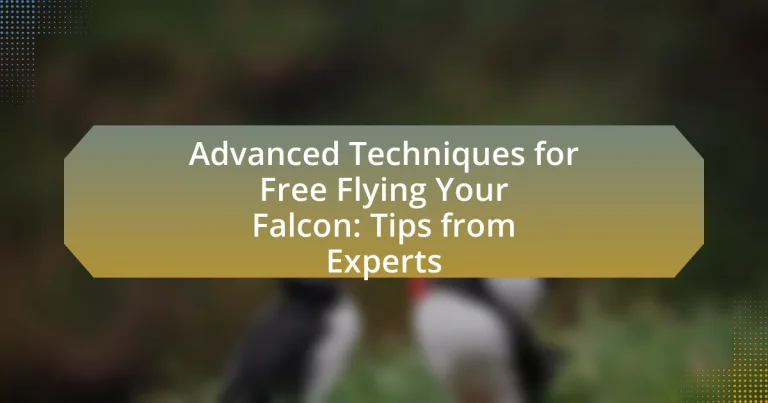The article focuses on advanced techniques for free flying falcons, emphasizing methods such as lure training, recall reinforcement, and environmental conditioning. It contrasts these modern approaches with traditional falconry methods, highlighting the importance of the falcon’s autonomy and natural behaviors. Key skills required for successful free flying include precise control and situational awareness, while the benefits of free flying encompass improved physical fitness, mental well-being, and a strengthened bond between falconer and falcon. The article also addresses essential equipment, common challenges, and best practices for maintaining a successful free flying routine, providing expert tips for falconry enthusiasts.
What are Advanced Techniques for Free Flying Your Falcon?

Advanced techniques for free flying your falcon include utilizing lure training, enhancing recall through consistent reinforcement, and employing environmental conditioning. Lure training involves using a bait, such as a piece of meat, to encourage the falcon to return after flight, which strengthens the bond between the falconer and the bird. Consistent reinforcement during recall training, where the falcon is rewarded for returning promptly, helps establish reliable flight patterns. Environmental conditioning, which involves gradually introducing the falcon to various outdoor settings, prepares the bird for real-world hunting scenarios and improves its adaptability. These techniques are supported by falconry practices that emphasize the importance of trust and communication between the falconer and the bird for successful free flying.
How do these techniques differ from traditional falconry methods?
Advanced techniques for free flying falcons differ from traditional falconry methods primarily in their emphasis on greater autonomy and natural behavior of the bird. Traditional falconry often involves more structured training and reliance on the falconer for direction and control, whereas advanced techniques focus on allowing the falcon to exhibit instinctual behaviors, such as hunting and foraging, in a more natural environment. This shift is supported by studies indicating that free-flying practices can enhance the bird’s physical fitness and mental well-being, as they engage in activities that mimic their wild counterparts.
What specific skills are required for advanced free flying?
Advanced free flying requires a combination of precise control, situational awareness, and advanced training techniques. Precise control involves mastering the falcon’s flight patterns and understanding its responses to various stimuli, which is essential for effective handling during free flight. Situational awareness is crucial for recognizing environmental factors such as wind conditions, terrain, and potential hazards that could affect the falcon’s performance. Advanced training techniques, including the use of lures and recall methods, enhance the falcon’s responsiveness and reliability in the field. These skills are supported by extensive practice and knowledge of falconry principles, ensuring successful and safe free flying experiences.
How do these techniques enhance the falcon’s natural abilities?
Techniques such as targeted training, environmental exposure, and positive reinforcement enhance the falcon’s natural abilities by improving its hunting skills, adaptability, and responsiveness. Targeted training focuses on specific behaviors, allowing falcons to refine their flight patterns and hunting techniques, which increases their efficiency in capturing prey. Environmental exposure helps falcons acclimate to various terrains and conditions, enhancing their ability to navigate and hunt in diverse settings. Positive reinforcement encourages desired behaviors, leading to improved trust and communication between the falcon and handler, which ultimately results in better performance during free flights.
Why is free flying important for falconry enthusiasts?
Free flying is important for falconry enthusiasts because it enhances the bird’s natural hunting instincts and promotes a strong bond between the falconer and the bird. Engaging in free flying allows the falcon to exercise its flight capabilities and develop essential skills for hunting, which are crucial for its overall well-being and performance. Studies have shown that birds that are regularly free flown exhibit improved physical fitness and mental stimulation, leading to a more fulfilled and healthier life in captivity.
What benefits does free flying provide for the falcon’s health and well-being?
Free flying significantly enhances a falcon’s health and well-being by promoting physical fitness and mental stimulation. Engaging in free flight allows falcons to exercise their muscles, improve cardiovascular health, and develop essential hunting skills, which are crucial for their overall vitality. Additionally, the experience of flying in natural environments reduces stress and anxiety, contributing to better mental health. Studies have shown that birds that engage in free flying exhibit improved behavioral patterns and increased social interactions, further supporting their psychological well-being.
How does free flying improve the bond between falconer and falcon?
Free flying enhances the bond between falconer and falcon by fostering trust and communication through shared experiences in a natural environment. When falcons are allowed to fly freely, they develop a sense of independence while still relying on their falconer for guidance and safety. This dynamic encourages the falcon to return to the falconer, reinforcing the relationship. Studies have shown that consistent free flying sessions lead to improved responsiveness and loyalty, as the falcon learns to associate the falconer with positive experiences, such as hunting and feeding.
What expert tips can enhance your free flying experience?

To enhance your free flying experience, focus on consistent training and understanding your falcon’s behavior. Regular practice helps build a strong bond and improves the falcon’s responsiveness to commands. Observing your falcon’s body language and flight patterns allows you to anticipate its needs and adjust your techniques accordingly. Additionally, utilizing varied environments for flying can stimulate your falcon’s instincts and enhance its performance. Research indicates that falcons thrive in diverse settings, which can lead to improved agility and hunting skills.
How can you prepare your falcon for free flying?
To prepare your falcon for free flying, start by ensuring it is well-trained in basic commands and has a strong bond with you. This foundational training includes consistent recall exercises and positive reinforcement to establish trust. Additionally, gradually acclimate the falcon to outdoor environments by introducing it to various settings while on a leash, allowing it to experience different sights and sounds without the risk of escape.
Proof of this method’s effectiveness can be found in falconry practices, where successful free flying relies on the falcon’s comfort and familiarity with its handler and surroundings. Studies show that falcons trained in controlled environments exhibit better performance and adaptability when transitioning to free flying.
What training methods are most effective for preparing a falcon?
The most effective training methods for preparing a falcon include the use of positive reinforcement, consistent handling, and gradual exposure to the environment. Positive reinforcement, such as offering food rewards, encourages desired behaviors and builds trust between the falcon and the handler. Consistent handling helps the falcon become accustomed to human presence and reduces stress during training sessions. Gradual exposure to various environments allows the falcon to adapt to different stimuli, which is crucial for successful free flying. These methods are supported by falconry practices that emphasize the importance of building a strong bond and ensuring the bird’s comfort and confidence in its surroundings.
How can you assess your falcon’s readiness for free flying?
To assess your falcon’s readiness for free flying, observe its physical condition, behavior, and training progress. A healthy falcon should exhibit strong muscle tone, good weight management, and an alert demeanor. Additionally, the falcon should respond reliably to commands and demonstrate consistent flight performance during training sessions. These indicators confirm that the bird is physically and mentally prepared for the challenges of free flying.
What equipment is essential for successful free flying?
Essential equipment for successful free flying includes a well-fitted harness, a reliable GPS tracking device, and a high-quality falconry glove. The harness ensures the bird’s safety and comfort during flight, while the GPS tracking device allows for real-time monitoring of the falcon’s location and behavior. A high-quality falconry glove protects the handler’s hand and provides a secure grip on the bird. These items are critical for effective management and safety in free flying, as they enhance both the falcon’s performance and the handler’s control.
Which types of gear should every falconer have?
Every falconer should have essential gear including a falconry glove, a hood, a leash, and a telemetry system. The falconry glove protects the falconer’s hand while handling the bird, ensuring safety and comfort. A hood is crucial for calming the bird during transport and training, as it restricts vision and reduces stress. A leash is necessary to maintain control of the bird during training sessions and to prevent escape. Lastly, a telemetry system is vital for tracking the bird’s location during free flights, enhancing safety and recovery efforts. These items are fundamental for effective falconry practice and are widely recognized as standard equipment among experienced falconers.
How does the choice of equipment impact the free flying experience?
The choice of equipment significantly impacts the free flying experience by influencing the bird’s performance, safety, and handler’s control. Specific equipment, such as the type of harness, leash, and telemetry system, directly affects how well the falcon can maneuver and respond to commands during flight. For instance, a well-fitted harness allows for greater freedom of movement, enabling the falcon to fly more naturally, while a poorly designed one can restrict movement and cause stress. Additionally, high-quality telemetry systems provide real-time tracking, enhancing safety by allowing handlers to locate their birds quickly if they stray too far. Studies have shown that equipment tailored to the specific needs of the falcon can lead to improved flight performance and a more enjoyable experience for both the bird and the handler.
What are common challenges in free flying and how can they be overcome?

Common challenges in free flying include loss of control, environmental hazards, and the falcon’s reluctance to return. These challenges can be overcome through consistent training, using telemetry devices for tracking, and establishing a strong bond with the falcon. Training helps the falcon understand commands and improve its responsiveness, while telemetry devices provide real-time location data, allowing for quick retrieval in case of loss. Building a strong bond through regular interaction and positive reinforcement encourages the falcon to return willingly, enhancing overall success in free flying.
What obstacles might falconers face during free flying sessions?
Falconers may face several obstacles during free flying sessions, including environmental factors, the behavior of the bird, and potential distractions. Environmental factors such as wind, rain, and temperature can affect the falcon’s performance and willingness to fly. The behavior of the bird itself, including its level of training and instinctual responses, can lead to challenges in maintaining control and ensuring the falcon returns. Additionally, distractions from other animals, people, or unexpected noises can disrupt the session, making it difficult for falconers to achieve their training goals.
How can weather conditions affect free flying activities?
Weather conditions significantly impact free flying activities by influencing visibility, wind patterns, and thermal currents. Poor visibility due to fog, rain, or snow can hinder a falconer’s ability to track their bird, increasing the risk of losing sight of it. Wind conditions, such as strong gusts or turbulence, can affect the bird’s flight stability and control, making it difficult for the falcon to navigate effectively. Additionally, thermal currents, which are essential for soaring, can be less predictable in adverse weather, limiting the bird’s ability to gain altitude and maintain flight. These factors collectively determine the safety and success of free flying activities.
What strategies can be employed to manage distractions for the falcon?
To manage distractions for the falcon, handlers can employ strategies such as consistent training, environmental control, and the use of distraction-reducing equipment. Consistent training reinforces the falcon’s focus on the handler and its tasks, which is essential for minimizing distractions. Environmental control involves selecting locations for flying that are free from potential distractions, such as loud noises or other animals, thereby creating a more conducive environment for the falcon’s concentration. Additionally, using equipment like hoods can temporarily limit the falcon’s vision, reducing its exposure to distractions during training sessions. These strategies are supported by falconry practices that emphasize the importance of a controlled environment and focused training to enhance the falcon’s performance and safety.
How can falconers troubleshoot issues during free flying?
Falconers can troubleshoot issues during free flying by closely observing the bird’s behavior and adjusting their techniques accordingly. For instance, if a falcon is not returning as expected, the falconer should assess environmental factors such as wind conditions or distractions in the area. Additionally, falconers can utilize training techniques, like recall training, to reinforce the bird’s return behavior. Monitoring the falcon’s health and ensuring it is well-fed before flying can also prevent issues related to motivation. These strategies are supported by the understanding that a falcon’s performance is influenced by both its training and external conditions.
What signs indicate that a falcon is not performing well in free flight?
Signs that indicate a falcon is not performing well in free flight include erratic flight patterns, excessive flapping, difficulty maintaining altitude, and failure to respond to commands. Erratic flight patterns may suggest a lack of focus or fatigue, while excessive flapping can indicate a struggle to gain or maintain speed. Difficulty maintaining altitude often points to insufficient strength or health issues, and failure to respond to commands may reflect a lack of training or motivation. These behaviors are critical indicators that require immediate attention to ensure the falcon’s well-being and performance.
How can falconers adjust their techniques based on their falcon’s behavior?
Falconers can adjust their techniques based on their falcon’s behavior by closely observing the bird’s responses during training and hunting. For instance, if a falcon shows signs of distraction or disinterest, falconers may modify their training sessions to include shorter, more engaging activities that capture the bird’s attention. Additionally, if a falcon exhibits aggressive behavior towards other birds, falconers might implement techniques that promote calmness, such as using positive reinforcement or altering the environment to reduce stressors. These adjustments are essential for ensuring effective communication and building a strong partnership between the falconer and the falcon, ultimately enhancing the success of free flying.
What are the best practices for maintaining a successful free flying routine?
The best practices for maintaining a successful free flying routine include consistent training, proper health management of the falcon, and environmental acclimatization. Consistent training involves regular practice sessions to reinforce skills and build a strong bond between the falcon and the handler. Proper health management ensures the falcon is in peak physical condition, which is crucial for performance; this includes regular veterinary check-ups and a balanced diet. Environmental acclimatization allows the falcon to adapt to various conditions, enhancing its ability to fly successfully in different settings. These practices are supported by expert recommendations in falconry literature, emphasizing the importance of routine and care in achieving optimal results in free flying.
How often should free flying sessions be conducted for optimal results?
Free flying sessions should be conducted at least three to four times a week for optimal results. Regular sessions help reinforce the falcon’s training, improve its flying skills, and enhance the bond between the falconer and the bird. Research indicates that consistent practice leads to better performance and responsiveness in free flying, as it allows the falcon to develop muscle memory and confidence in its abilities.
What post-flight care is essential for the falcon’s recovery?
Post-flight care essential for a falcon’s recovery includes providing adequate hydration, nutrition, and rest. Hydration is crucial as falcons can become dehydrated after flight; offering fresh water immediately after landing helps restore fluid balance. Proper nutrition, such as high-quality prey or formulated diets, supports energy recovery and muscle repair. Additionally, allowing the falcon to rest in a quiet, safe environment minimizes stress and aids in recovery. These practices are supported by avian veterinary guidelines, which emphasize the importance of hydration and nutrition in raptor care for optimal health and recovery.


